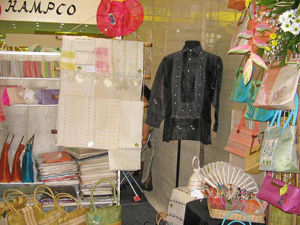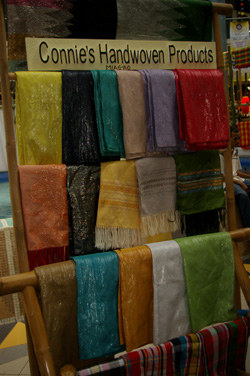Western Visayas textile industry, in for a second coming

Aklan exhibit
Iloilo had long lost its title of being the "Textile Center of the Philippines" but Western Visayas can still lay claim to being the capital of handwoven fabrics in the country today. Deep in the remote villages of this region, the heavy thud of handlooms continue to steal quiet afternoons as women weave the Patadyong in Antique, the Hablon in Iloilo and Piña in Aklan.
With the demand in handwoven fabric now on the rise, Western Visayas textile industry is in for a second coming. This time though, it is no ordinary segment of the textile industry but its significant other as it raises the ante for artistry, creativity and craftsmanship

hablon scarves on display, Hablon Moda 2006
at Robinsons Iloilo
A bit of history
Much like the fabric they produce the women weavers of Western Visayas could very well be the warp and weft of trade and culture here as they manage to sustain this tradition of patience, endurance and creativity that drove 18th century commerce in the region to a new grind.
The transition of the southeastern Panay from a subsistence farming economy to commercial textile production during the middle of the 18th century and the subsequent growth of Iloilo s Jaro, Molo and Arevalo as the first urban concentration in Western Visayas is attributed to the influx of women weavers. Referred to as the "textile era" by historians and researchers, textile production 19th century Iloilo reached remarkable degree of development to earn the title "textile center of the Philippines ."
But even as these primitive weaving looms have been replaced by big industrial machines drastically changing the character of the textile industry, handloom weaving remains a traditional craft in the region that refuses to bow out to oblivion.
Iloilos Hablon, refined through the ages
The towns of Miagao, Oton and Dueñas are Iloilo s major producers of handwoven fabric. In Oton, women of Barangay Cagbang still create artistry on the loom weaving a beautiful fabric synonymous to Iloilo —the Hablon.
Among them is retired teacher , Ana Cordero, who as a child remembers having about 40 handlooms in their home where her mother and other weavers worked on.. But through the years, for one reason or another, these were gone.
In 1969, Cordero who had just started a teaching career that would last 30 years took to weaving again. What she had then was a small loom she uses to weave straw mats on. Before she knew it her small hobby started to get attention and then was born the Oton Woven products, a small business she did on the side. Her woven straw mats also drew in the traditional woven textiles. In time she learned the "refinements" of the traditional craft and improved on some aspects of the craft her mother grappled with in the past. "Shrinkage" was one of them, she said..
When she retired in 1998, she devoted more time to her small business and this gave her wider latitude. Her exposure to trade fairs here and abroad allowed her to market her products to more people as well as to learn more.
At Corderos yard, 71 year old Mercedes Compana and 46 year old Fe Canzon are doing a couple of orders on the loom. Both women learned the craft from their respective mothers. Aling Mercedes learned to weave when she was 18 years old. Aling Fe learned just about the same age.
Much like Patadyong weaving, the setting up includes unwinding the silk threads from the cones bought from commercial establishments and meticulously laying these strands onto the sab-ong. Another set of thread, likis, is rolled in tidal. Still another set is transferred into smaller spools or "lansadera" and these makes for the warp and weft to weave the fabric. In cases where the order requires an inset design (pulot), a salidsid or a bamboo slat that holds the string that creates the inset design is set in place.
It takes about a day to complete a meter of Hablon with the simplest design and 40 cones of 500 yards to complete 3 meters of the cloth.
Today, the Iloilo Office of the Department of Trade and Industry (DTI) counts about three cooperatives and 14 single proprietorship firms doing handwoven products here.
Aklans Piña Cloth, a matrilineal tradition
Likewise a matrilinear tradition, the delicate craftsmanship of the handwoven pina cloth had been passed on by mothers across several generations to their daughters. Noted weavers of this natural fiber are in Buswang and Bakhaw communities, in the capital town of Kalibo . A trip to Aklan will never be complete without a visit to the Dela Cruz House of Pina still ably mentored by the clans grand matriarch, Susima Marte Dela Cruz
A well-known master of the craft, Nanay Susing started weaving at age16. She learned pina weaving from her mother Ursula Collendres Marte who in turn learned from her mother, Teodora. She said, it was by observing and assisting her mother set-up the lindog (warp) and the binting (reed) that she learned the rudiments of the craft.
Nanay Susing says Piña weaving requires a great deal of patience and finger dexterity as the 'hueog (weft) is a very fine fiber that easily breaks. Unlike the materials used in Hablon and Patadyong that are easily bought over the counter, the Piña fiber is a natural extract from the leaves of the native pineapple.
Removed of its gelatinous pulp, the white fine strands of the pina leaf called "liniwan" are washed, dried and knotted to create miles and miles of pina thread. An experienced knotter can do about 5 to 8 grams of fiber a day. About 16 to 18 grams of thread is needed to weave one yard of pina cloth. From here the threads are set up on the loom. This is called warping and it takes one month to put this up. When the loom is ready, a "banca" or shuttle that contains the same thread goes through the warp to finally weave the special fabric. It takes a whole day to weave half a meter of a plain pina cloth.
It takes a little more time to weave with inset designs. And doing the intricate suksuk (inset designs) had been Nanay Susings forte. These inset designs make the pina cloth more regal. To do this, heddles are set up as guide to a pattern. A simple inset design requires setting-up of 10 to 20 heddles or guide. A complex design requires more than a hundred heddles.
Nanay Susing recalls that her mother and grandmother are experts in suksuk as they only visualize the pattern and set-up the heddles without having to execute the design on paper.
Today, Nanay Susings three daughters have been assisting her manage the business. About 40 'manoghaboe (weavers) are in their employ. Libay is in charge of marketing, Ding is the overall manager, and Let, an industrial engineer is in charge of production. It is she that has taken the role of an apprentice in the fine craft of weaving and likely to be the purveyor of this tradition to the next generation of Dela Cruz women.
Antiques Patadyong, from tapis to blazers
In Barangay Bagtason, in Antiques Bugasong town, handlooms stand in the front, side or backyard of just about every other house. No one complains of the heavy thud reverberating in the neighborhood. The women are weaving various patterns of the multi colored plaid. Lest one imagines Antiquenos still wrapped in tapis, todays Patadyong no matter how traditional has managed to go mainstream as it is used like any clothing material — from the long dress to mini skirts, tube tops to blazers. Going beyond weaving, the women here also make hats and bags including celfone stringbags from Patadyong fabric.
Here too in Antique, local leaders are spreading the mantle of friendship through the Patadyong. Along with muscovado sugar, the patadyong is always part of official gifts presented to visiting dignitaries.
